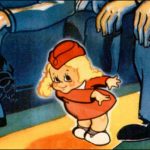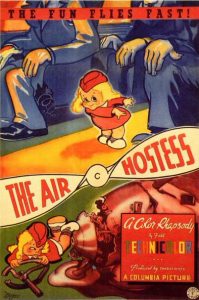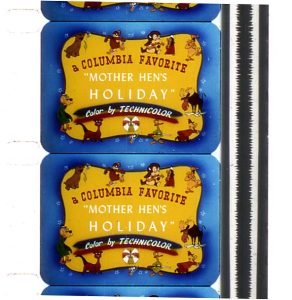


 Nothing much new in Columbia’s cartoon division for this period, but they were continuing to improve their craft – at least for awhile. While the Scrappys and Krazy Kat’s conttinued overall to look of good quality, some with improving, more dimensional character design, the Color Rhapsodies sometimes ranged widely in quality. Ub Iwerks’ new additions to the lineup were consistent, but the in-house product seemed to show some production problems, and some questionable character design. This was a period when Mintz began to become associated with “cherubic” characters, including a little boy which Totally Tooned In named “Sparky”, a quartet of Air Hostesses, and a character who, despite her outlandishly-rosy cheeks (a trait shared with the premiere appearance of “Sparky”), gained the attention of the Academy for a rare Oscar nomination for The Little Match Girl, a substantially more serious presentation of a theme already utilized by the studio in the previous Scrappy production, The Match Kid. Aside from this “cherub” period, there were also signs that budgets or manpower might have been being strained for some color productions, as both The Air Hostess and Match Girl include several group shots which fall back on rather crudely-drawn repeating cycles of animation, the same action being repeated over and over about three times per shot.
Nothing much new in Columbia’s cartoon division for this period, but they were continuing to improve their craft – at least for awhile. While the Scrappys and Krazy Kat’s conttinued overall to look of good quality, some with improving, more dimensional character design, the Color Rhapsodies sometimes ranged widely in quality. Ub Iwerks’ new additions to the lineup were consistent, but the in-house product seemed to show some production problems, and some questionable character design. This was a period when Mintz began to become associated with “cherubic” characters, including a little boy which Totally Tooned In named “Sparky”, a quartet of Air Hostesses, and a character who, despite her outlandishly-rosy cheeks (a trait shared with the premiere appearance of “Sparky”), gained the attention of the Academy for a rare Oscar nomination for The Little Match Girl, a substantially more serious presentation of a theme already utilized by the studio in the previous Scrappy production, The Match Kid. Aside from this “cherub” period, there were also signs that budgets or manpower might have been being strained for some color productions, as both The Air Hostess and Match Girl include several group shots which fall back on rather crudely-drawn repeating cycles of animation, the same action being repeated over and over about three times per shot.
 Yet, immediately preceding these productions, the studio would create a marvelous jazz cartoon (not included here, due to use of songs already covered elsewhere), called Swing, Monkey, Swing, which, despite also using several repeating cycles to conserve on budget, is masterfully drafted, and gives one the feeling of a Harman-Ising Happy Harmony from a parallel universe. What exactly was behind all this is unknown, but artifacts of poor draftsmanship begin the creep more regularly into the non-Iwerks color productions well into 1939. In contrast, Iwerks seems to turn on the steam during this period, making bolder use of three-strip Technicolor, and even honing his gag timing, so that within a year of so, some of his films would seem to possess imagery and timing which sometimes held a glimmer of the work of Warner Brothers. It would not be long before the studio’s head would fall upon ill health, depriving the animation units of the leadership needed to create a consistent and quality product, which would eventually lead to quite a revolving door of changes in management which would continue throughout the 1940’s, in search of finding a definitive identity and house style for the studio’s product. But, we get ahead of our story.
Yet, immediately preceding these productions, the studio would create a marvelous jazz cartoon (not included here, due to use of songs already covered elsewhere), called Swing, Monkey, Swing, which, despite also using several repeating cycles to conserve on budget, is masterfully drafted, and gives one the feeling of a Harman-Ising Happy Harmony from a parallel universe. What exactly was behind all this is unknown, but artifacts of poor draftsmanship begin the creep more regularly into the non-Iwerks color productions well into 1939. In contrast, Iwerks seems to turn on the steam during this period, making bolder use of three-strip Technicolor, and even honing his gag timing, so that within a year of so, some of his films would seem to possess imagery and timing which sometimes held a glimmer of the work of Warner Brothers. It would not be long before the studio’s head would fall upon ill health, depriving the animation units of the leadership needed to create a consistent and quality product, which would eventually lead to quite a revolving door of changes in management which would continue throughout the 1940’s, in search of finding a definitive identity and house style for the studio’s product. But, we get ahead of our story.
Mother Hen’s Holiday (5/7/37) – Mother hen is trying to get some rest after a long day, but her brood of chicks is having none of it. Being young-uns, they want to have fun and make mischief, while Mama would prefer to sit and rock. They drive Mama into a panic, demanding their dinner, and keeping her racing one step behind their trail of destruction. However, the kids finally notice that today is Mother’s Day, and realize they should be doing things for her. This cartoon is more gag oriented than usual for a Color Rhapsody. Song: “My Work Is Never Done”, sung by Mother as she tries to clean up the place – an original.
Indian Serenade (7/16/37) – A young native-American maiden and boy pitch woo, while the brave’s dog Yippee gets himself thoroughly entrenched within the products of a potter’s wheel, having all four paws, rear and head trapped in earthen jugs. After narrowly averting waltzing off the end of a log overhanging a cliff, Yippee finally emerges from the pots, only to find himself face-to-face with a huge rattlesnake. A speedy chase begins, and arrows fly from the brave’s bow (all missing), but the Indian maiden decides things have gone too far out of hand. She stops the snake in his tracks with a stern womanly scold, then takes the snake across her knee, delivering a sound spanking, and sends it slinking away, to the laughter of the local animal community. Yippee can’t resist a final urge to humiliate the snake by shaking its rattle like a baby. Song: a nameless Indian intermezzo, written after the fashion of such songs as “Pale Moon” and “By the Waters of Minnetonka”, probably penned by De Nat.
I Wanna Be An Actress (7/18/37) – Margie is towing a coaster wagon past Scrappt’s backlot movie studio, identified by a handmade sign atop the gate. Even though Margie puts on her best Greta Garbo and Katherine Hepburn impressions, Scrappy orders her out. However, Oopie sees her potential, and they wind up in a musical production number, set to the song, “Sing, Baby, Sing”, the title number from an Alice Faye feature of the same from Fox. Ruby Newman’s Orchestra, a society-type group, got the Victor recording, while the Bluebird version went to the fairly-young and swinging Charlie Barnet Orchestra (below). Teddy Wilson had a Brunswick date, featuring several Benny Goodman sidemen. Johnny Johnson got the dime store version for Melotone et al. Putney Dandridge issued a Vocalion cover, primarily aimed, as many Vocalion issues were at the time, straight for the juke box trade. Across the pond, Jack Hylton recorded it for HMV. Harry Roy covered it for Parlophone. A late east German version appeared post-war on Amiga by the Rundfunk-Tanzorchester Leipzig, directed by Kurt Henkels.
Spring Festival (8/6/37) – Cute cherubic characters announce the time for a change of seasons by knocking on Mother Nature’s door, and she responds by summoning Spring. The flowers are blooming and showing off their color. No particular stand-out gags, but an agreeable color palette. Songs: all originals. “Spring Is In The Air”, “We’re the Flowers That Bloom In the Spring” (avoiding direct nod to Gilbert and Sullivan), “Pretty Little Butterfly”, and “Thistles are Blooming” (delivered much in the style of Harry Lauder).
Scary Crows (8/20/37) – It’s morning on the farm, and the rooster is performing his usual duties, waking everyone at dawn. The farmer (“Sparky”, at last without those too-rosy cheeks) is busily trying to sew seeds. Sparky’s dog is enduring interference from a group of crows, out to get the seeds. The crows do not have any perceptible personalities – just ravenous appetites. Excellent effects are used here in lighting as the day begins and ends, with brighter and darker colors as the scene demands. Sparky is kept up virtually all night, and is still trying to get some sleep when the rooster announces the start of another day. Songs: “Early In the Morning (When The Sun Begins To Rise)”, an original; “Oh, Dear, What Can the Matter Be”, with a new set of lyrics; and another original song. title uncertain, but about the end of a long day.
The Air Hostess (10/22/37) – Four young budding air hostesses are being trained by an adult experienced stewardess. One young girl winds up assigned to the flight of an equally- young junior pilot, who crash-lands upon arrival at the airport, then desperately tries to reassemble his shattered plane for takeoff on the next scheduled departure. The hostess tries to keep the passengers from rioting by engaging in song, while the pilot still has the cabin split in half by a rising jack. Eventually, it looks like a takeoff is imminent, but the whole thing falls apart again, and pilot and stewardess end the film rising from the rubble. Songs: “Come Take a Trip In My Airship”, which we’ve seen from previous Max Fleischer films; “The Stewardess Song”, as the senior stewardess gives the hostesses training; and another original sung by the hostess to the passengers, which I’ll simply call “The Air Hostess Song”, the latter two originals.
Railroad Rhythm (11/20/37) – Krazy Kat is running an old-time steam train, and somewhat yearning over the more modern streamlined models. The ride seems to be bumpy for the passengers, and for the crew as well, including a Stepin Fetchit-inspired porter. Along, the way, this cartoon veers into melodrama spoof, as an unnamed villain ties Handsome Harry and Winsome Winnie to the tracks and delivers his monologue. A rescue is made by Krazy, and the couple’s marriage is announced and accomplished. Surprisingly, while there is a custom car for the Justice of the Peace, there is not a separate car for the mother-in-law. Eventually, Krazy is rewarded by receiving the streamlined train to operate. There’s even a gag where the train goes through a tunnel, which looks like it could have popped up from an Oswald or early Bosko cartoon. Song: “I Wonder Where My Easy Rider’s Gone”, introduced by Mae West in 1933’s “She Done Him Wrong”. West recorded it for Brunswick. Victor covered it with Hannah’s Hot Shots, actually Beth Challis, a vaudeville singer who had recorded in the 1920’s.
Hollywood Picnic (12/18/37) – Hollywood’s star community is out enjoying a picnic, complete with baseball game and everything. Stars that get toasted in the cartoon include W.C. Fields, Katherine Hepburn, Stepin Fetchit (slow until it’s time to eat, and then Jesse Owens) and Greta Garbo. The baseball game includes the Three Stooges and the Marx Brothers. Song: “Truckin’”, a 1935 rhythm number, given in the cartoon to a Martha Raye caricature. It was recorded by Duke Ellington for Brunswick The Mills Blue Rhythm Band covered it for Columbia. And Billy Cotton got it for Regal Zonophone in England.
NEXT TIME: Into 1938.